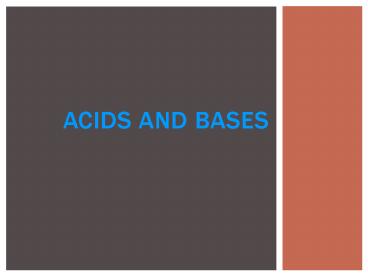Acids and Bases - PowerPoint PPT Presentation
1 / 13
Title:
Acids and Bases
Description:
ACIDS AND BASES ACIDS Taste sour Turn litmus React with active metals above hydrogen in the activity series React with bases BASES Taste bitter Turn litmus Feel soapy ... – PowerPoint PPT presentation
Number of Views:77
Avg rating:3.0/5.0
Title: Acids and Bases
1
Acids and Bases
2
General properties
- ACIDS
- Taste sour
- Turn litmus
- React with active metals above hydrogen in the
activity series - React with bases
- BASES
- Taste bitter
- Turn litmus
- Feel soapy or slippery (react with fats to make
soap) - React with acids
blue to red
red to blue
3
Definitions
Arrehenius
- Acids produce H3O
- Bases - produce OH-
- Acids donate H
- Bases accept H
- Acids accept e- pair
- Bases donate e- pair
only in water
Bronsted-Lowry
any solvent
Lewis
used in organic chemistry, wider range of
substances
4
Arrhenius acid is a substance that produces H
(H3O) in water
Arrhenius base is a substance that produces OH-
in water
5
A Brønsted-Lowry acid is a proton donor A
Brønsted-Lowry base is a proton acceptor
conjugate base
conjugate acid
acid
base
6
Lewis Acid/Base Reaction
7
The Bronsted-Lowry Concept
Conjugate pairs
CH3COOH CH3COO-
HCl Cl-
NH4 NH3
HNO3 NO3-
How does a conjugate pair differ?
H transfer
8
Neutralization
In general Acid Base ? Salt Water
All neutralization reactions are double
displacement reactions.
HCl NaOH ? NaCl HOH
HCl Mg(OH)2 ?
9
ACID - BASE TITRATIONS
- This is a neutralization reaction used in
Chemistry lab to determine the concentration of
an acid or a base - use a base or an acid with a known concentration
to neutralize the acid or base with the unknown
concentration EQUATION TO USE FOR SOLVING
TITRATION PROBLEMS nA MA .VA nB MB
VB - nA number of Hs at the beginning of the
formula for the acid MA molarity of the acid
VA volume of the acid nB number of OHs in
the formula for the base MB molarity of the
base VB volume of the base EXAMPLE PROBLEM
What is the molarity of a H2SO4 solution if 190
mL of the acid is needed to exactly neutralize
150 mL of a 2.5 M NaOH solution? - 2 . MA . 190 mL 1 . 2.5 M . 150 mL
- MA 0.99M
10
pH scale (Negative Log Function)
pH 0 H 1x100 M 1M pH 1 H
1x10-1M 0.1M pH 2 H 1x10-2M 0.01M
pH 3 H 1x10-3M 0.001M pH 4 H
1x10-4M 0.0001M pH 5 H 1x10-5M
0.00001M pH 6 H 1x10-6M 0.000001M pH
7 H 1x10-7M 0.0000001M pH 8 H
1x10-8M 0.00000001M pH 9 H 1x10-9M
0.000000001M pH 10 H 1x10-10M
0.000000001M pH 11 H 1x10-11M
0.0000000001M pH 12 H 1x10-12M
0.00000000001M pH 13 H 1x10-13M
0.000000000001M pH 14 H 1x10-14M
0.0000000000001M Note Every time the pH of a
substance goes up by 1, the concentration of H
goes down by a factor of ten, which is why you
take the negative log of H to get pH pH
-logH H 10-pH
11
H, OH-, pH and pOH
- H the molarity of H in the solution
- OH- the molarity of OH- in the solution
- When H OH-, the solution is neutral
- HOH- 1x10-14
- pH parts hydrogen
- Friendly number between 1 and 14 used to describe
the acidity or basicity of a substance relative
to water - Derived from the exponent of the concentration of
H - pOH parts hydroxide
- Similar to pH, but derived from the concentration
of OH- - Since acids and bases are opposites, pH and pOH
are opposites! - pH pOH 14
12
pH H pOH OH-
13
Conversions































